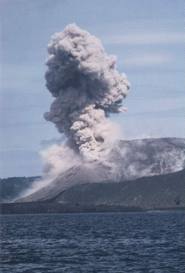Volcanoes form where magma reaches Earth’s surface.
Volcano: the opening in Earth’s crust through which magma, gases, and ash erupt, and the landform that develops  around this opening
around this opening
*A volcanic eruption occurs when magma rises to the surface.
–How does this magma form? 3 ways:
1. A decrease in pressure– lowers melting temperature and allows solid rock to melt
-Occurs at divergent boundaries.
2. An increase in temperature– melts rock
-Occurs at a hot spot.
3. An increase in the amount of water in the asthenosphere– lowers melting temperature and allows solid rock to melt
-Occurs at subduction boundaries.
-Once magma is formed, it rises to the surface because it is less dense than the solid materials around it!
*3 Places Volcanoes Form:
1. At Subduction Boundaries– When an oceanic plate is forced beneath another plate, volcanoes always form on the overriding (top) plate.
-If the top plate is a continental plate, a range of mountains and volcanoes forms.
Ex.- Cascade Range
-If the top plate is an oceanic plate, a chain of volcanic islands called a volcanic island arc forms.
Ex.- islands of Indonesia
2. At Divergent Boundaries– Most of the magma that reaches Earth’s surface does so here, along the mid-ocean ridges.
-Thus, most of Earth’s volcanic activity takes place beneath the oceans!
3. Over Hot Spots– areas of volcanic activity that form from plumes of hot, solid material that have risen from deep within Earth’s mantle
-A hot spot stays in the same place in the mantle, as the lithospheric plate slides over it.
-Forms a chain of volcanoes on the plate as the plate moves across the hot spot.
Ex.- Hawaiian Islands
-The largest and youngest island, Hawaii, currently lies over the hot spot, as this island is still volcanically active! Other islands have moved past the hot spot, and are thus extinct volcanoes.
Examples
North American Plate:
Name of Volcano: Augustine Volcano
- Last Eruption: January 2006
- Current status: active
- Brief story: Augustine Volcano is located on Augustine Island in Alaska. It is also one of the utmost hazards in Alaska.
South American Plate
Name of Volcano: Mount Hudson
- Last Eruption: October 1991
- Current status: volcanic activity occurs inside the caldera (a crater caused by the collapse of the volcano)
- Brief story: The eruption in 1991 was one of the largest in the twentieth century. It is covered by a glacier in Chile.
African Plate
Name of Volcano: Erta Ale
- Last Eruption: 2006
- Current status: active
- Brief story: Erta Ale is located in Ethopia and is recognized for its lava lake activity. It has erupted 7 times within the past 125 years.
Eurasian Plate
Name of Volcano: Mount Fuji
- Last Eruption: from December 1707 to January 1708 lasting 16 days
- Current status: dormant; eruptions may take place in the future
- Brief story: Mount Fuji is one of Japan’s most famous landmarks located west of Tokyo and its highest mountain. The name, Fuji, in Japanese means wealth. To the Shinto and Buddhism religions, Mount Fuji is very sacred in their history.
Philippines Plate
Name of Volcano: Mayon Volcano
- Last Eruption: August 2006
- Current status: active
- Brief story: Mayon volcano sits on Luzon in the Philippines. Like other volcanoes, it also has been considered as an equivalent to Mount Fuji as it almost has perfectly- shaped cone. Lastly, it is the most active volcano in the Philippines because it has erupted over 50 times within the past 400 years.
